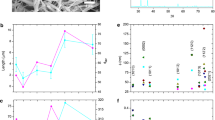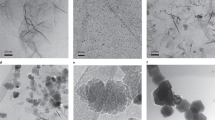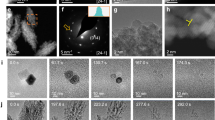Abstract
Although the classical picture of crystallization depicts a simple and immediate transformation from an amorphous to a crystalline phase, it has been argued that, in selected systems, intermediate metastable phases exist before a stable state is finally reached. However, most experimental observations have been limited to colloids and proteins, for which the crystallization kinetics are fairly slow and the size is comparatively large. Here, we demonstrate for the first time in an inorganic compound at an atomic scale that an amorphous phase transforms into a stable crystalline state via intermediate crystalline phases, thus directly proving Ostwald’s rule of stages. Through in situ high-resolution electron microscopy in real time at a high temperature, we show the presence of metastable transient phases at an atomic scale during the crystallization of an olivine-type metal phosphate. These results suggest a new description for the kinetic pathway of crystallization in complex inorganic systems.
This is a preview of subscription content, access via your institution
Access options
Subscribe to this journal
Receive 12 print issues and online access
$209.00 per year
only $17.42 per issue
Buy this article
- Purchase on Springer Link
- Instant access to full article PDF
Prices may be subject to local taxes which are calculated during checkout






Similar content being viewed by others
References
Burda, C, Chen, X., Narayanan, R. & El-Sayed, M. A. Chemistry and properties of nanocrystals of different shape. Chem. Rev. 105, 1025–1102 (2005).
Oxtoby, D. W. Homogeneous nucleation—theory and experiment. J. Phys. Condens. Matter 4, 7627–7650 (1992).
Oxtoby, D. W. Nucleation of first-order phase transitions. Acc. Chem. Res. 31, 91–97 (1998).
Mullin, J. W. Crystallization 4th edn 181–288 (Elsevier, 2004).
Ostwald, W. Studien über die Bildung und Umwandlung fester Körper. Z. Phys. Chem. 22, 289–330 (1897).
Ten Wolde, P. R. & Frenkel, D. Enhancement of protein crystal nucleation by critical density fluctuations. Science 277, 1975–1978 (1997).
Vekilov, P. G. Dense liquid precursor for the nucleation of ordered solid phases from solution. Cryst. Growth Des. 4, 671–685 (2004).
Auer, S. & Frenkel, D. Prediction of absolute crystal-nucleation rate in hard-sphere colloids. Nature 409, 1020–1023 (2001).
Anderson, V. J. & Lekkerkerker, H. N. W. Insight into phase transition kinetics from colloid science. Nature 416, 811–815 (2002).
Sanz, E., Valeriani, C., Frenkel, D. & Dijkstra, M. Evidence for out-of-equilibrium crystal nucleation in suspensions of oppositely charged colloids. Phys. Rev. Lett. 99, 055501 (2007).
Anwar, J. & Boateng, P. K. Computer simulation of crystallization from solution. J. Am. Chem. Soc. 120, 9600–9640 (1998).
Lutsko, J. F. & Nicolas, G. Theoretical evidence for a dense fluid precursor to crystallization. Phys. Rev. Lett. 96, 046102 (2006).
Yau, S.-T. & Vekilov, P. G. Quasi-planar nucleus structure in apoferritin crystallization. Nature 406, 494–497 (2000).
Gasser, U., Weeks, E. R., Schofield, A., Pusey, P. N. & Weitz, D. A. Real-space imaging of nucleation and growth in colloidal crystallization. Science 292, 258–262 (2001).
Gliko, O. et al. A metastable prerequisite for the growth of lumazine synthase crystals. J. Am. Chem. Soc. 127, 3433–3438 (2005).
Boerrigter, S. X. M. et al. In situ observations of epitaxial polymorphic nucleation of the model steroid methyl analogue 17 norethindrone. J. Phys. Chem. B 106, 4725–4731 (2002).
Stoica, C. et al. Epitaxial 2D nucleation of metastable polymorphs: A 2D version of Ostwald’s rule of stages. Cryst. Growth Des. 5, 975–981 (2005).
Ross, F. M., Tersoff, J. & Tromp, R. M. Coarsening of self-assembled Ge quantum dots on Si(001). Phys. Rev. Lett. 80, 984–987 (1998).
Hansen, P. L. et al. Atomic-resolved imaging of dynamic shape changes in supported copper nanocrystals. Science 295, 2053–2055 (2002).
Helveg, S. et al. Atomic-scale imaging of carbon nanofibre growth. Nature 427, 426–429 (2004).
Howe, J. M. & Saka, H. In situ transmission electron microscopy studies of the solid–liquid interfaces. MRS Bull. 29, 951–957 (2004).
Sutter, P. W. & Sutter, E. A. Dispensing and surface-induced crystallization of zeptolitre liquid metal-alloy drops. Nature Mater. 6, 363–366 (2007).
Hovmöller, S., Sjögren, A., Farrants, G., Sundberg, M. & Marinder, B.-O. Accurate atomic positions from electron microscopy. Nature 311, 238–241 (1984).
Weirich, T. E., Ramlau, R., Simon, A., Hovmöller, S. & Zou, X. A crystal structure determined with 0.02 Å accuracy by electron microscopy. Nature 382, 144–146 (1996).
Zou, X. & Hovmöller, S. Electron crystallography: Imaging and single-crystal diffraction from powders. Acta Crystallogr. A 64, 149–160 (2008).
Santoro, R. P. & Newmann, R. E. Antiferromagnetism in LiFePO4 . Acta Crystallogr. 22, 344–347 (1967).
Papike, J. J. & Cameron, M. Crystal chemistry of silicate minerals of geophysical interest. Rev. Geophys. Space Phys. 14, 37–80 (1976).
Chung, S.-Y., Bloking, J. T. & Chiang, Y.-M. Electronically conductive phospho-olivines as lithium storage electrodes. Nature Mater. 1, 123–128 (2002).
Tang, P. & Holzwarth, N. A. W. Electronic structure of FePO4, LiFePO4, and related materials. Phys. Rev. B 68, 165107 (2003).
International Tables for Crystallography 5th edn, Vol. A: Space-Group Symmetry (ed. Hahn, T.) (Springer, 2005).
Billinge, S. J. L. & Levin, I. The problem with determining atomic structure at the nanoscale. Science 316, 561–565 (2007).
Massa, W. Crystal Structure Determination 2nd edn (Springer, 2004).
Hovmöller, S. CRISP: crystallographic image processing on a personal computer. Ultramicroscopy 41, 121–135 (1992).
Gramm, F. et al. Complex zeolite structure solved by combining powder diffraction and electron microscopy. Nature 444, 79–81 (2006).
Baerlocher, C. et al. Structure of the polycrystalline zeolite catalyst IM-5 solved by enhanced charge flipping. Science 315, 1113–1116 (2007).
Shannon, R. D. Revised effective ionic radii and systematic studies of interatomic distances in halides and chalcogenides. Acta Crystallogr. A 32, 751–767 (1976).
Chung, S.-Y., Choi, S.-Y., Yamamoto, T. & Ikuhara, Y. Atomic-scale visualization of antisite defects in LiFePO4 . Phys. Rev. Lett. 100, 125502 (2008).
Acknowledgements
This work was supported by the Korea Research Foundation, grant no. 2007-331-D00196.
Author information
Authors and Affiliations
Contributions
S.-Y.C. conceived, designed and carried out the experiments, analysed the data, interpreted and discussed the results and wrote the paper. Y.-M.K., J.-G.K. and Y.-J.K. provided the TEM facilities and contributed the acquisition of TEM data.
Corresponding author
Supplementary information
Supplementary Information
Supplementary Informations (PDF 1729 kb)
Rights and permissions
About this article
Cite this article
Chung, SY., Kim, YM., Kim, JG. et al. Multiphase transformation and Ostwald’s rule of stages during crystallization of a metal phosphate. Nature Phys 5, 68–73 (2009). https://doi.org/10.1038/nphys1148
Received:
Accepted:
Published:
Issue Date:
DOI: https://doi.org/10.1038/nphys1148
This article is cited by
-
Impact of molecular symmetry on crystallization pathways in highly supersaturated KH2PO4 solutions
Nature Communications (2024)
-
Atomic-scale observation of premelting at 2D lattice defects inside oxide crystals
Nature Communications (2023)
-
Amyloid formation as a protein phase transition
Nature Reviews Physics (2023)
-
Influence of PAN/PANI polymer on low-temperature rate performance of LiFePO4
Ionics (2023)
-
Controllable Morphologies and Photoluminescence Properties of Polyoxometalates Doped EuF3 Nanoparticles
Journal of Cluster Science (2023)



